What is a Coolant Temperature Sensor?
A coolant temperature sensor, often abbreviated as CTS, is a small device placed in your car’s engine. Its primary function?
Purpose of the Sensor
The sensor keeps tabs on the engine’s coolant temperature. When things get too hot, it sends a warning to the car’s computer system, letting it know that the engine needs to cool down. Think of it like a thermometer for your car, but way more sophisticated.
How it Works
Magic? Sorcery? Nope, just good ol’ science. The sensor measures the resistance of the coolant, which changes as the temperature rises or drops. Based on these readings, it sends signals to the engine’s control module. And like a dutiful assistant, the car then adjusts the fuel injection, ignition timing, and, in some cases, the variable valve timing. Pretty neat, right?
Importance of a Coolant Temperature Sensor
Okay, you might ask, why all this fuss over a tiny sensor?
- Role in Engine Performance: The engine is like the heart of your car. And for it to function optimally, it needs to stay within a certain temperature range. The sensor ensures the engine runs efficiently, helping in smoother acceleration and better fuel combustion.
- Preventing Overheating: Imagine running a marathon in a thick winter jacket. You’d overheat pretty quickly, right? Similarly, the sensor prevents the engine from overheating by making sure it gets the right amount of coolant.
Signs of a Failing Sensor
But like all good things, sensors can go bad. How can you tell if yours is on the fritz?
- Fluctuating Temperature Gauge: Ever noticed your car’s temperature gauge acting like a yo-yo? This could be a sign of a failing sensor. Not something you’d want to ignore!
- Poor Fuel Efficiency: If you find yourself making frequent stops at the gas station, your sensor might be to blame. A malfunctioning sensor can mess with the fuel-to-air ratio, leading to decreased fuel efficiency.
- Engine Overheating: This one’s a no-brainer. If your engine’s overheating, the sensor is probably not doing its job.
Replacing a Faulty Sensor
So, what should you do if your trusty sensor gives up the ghost?
- DIY vs. Professional Help: Some car enthusiasts might fancy replacing the sensor themselves. And while it’s doable, it’s not a walk in the park. For those who aren’t mechanically inclined, it’s a good idea to leave it to the pros.
- Cost Factors: Replacement costs can vary based on the make and model of your car, and where you live. But typically, they’re relatively affordable. It’s a small price to pay for the peace of mind knowing your engine’s in good hands.
